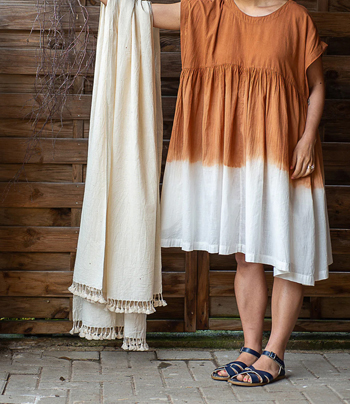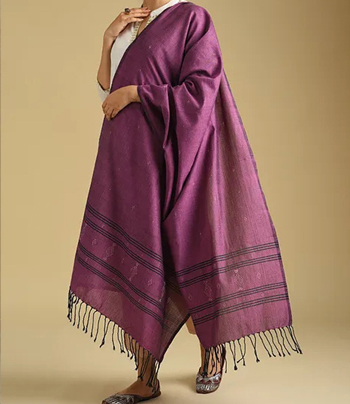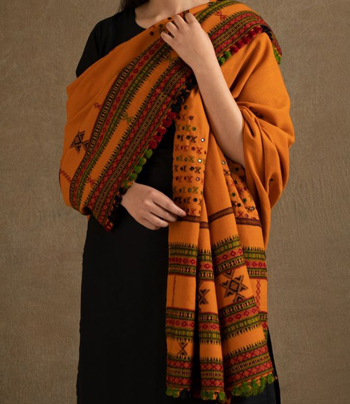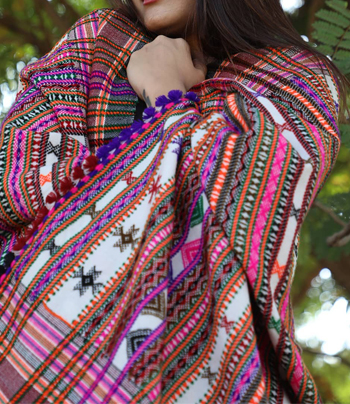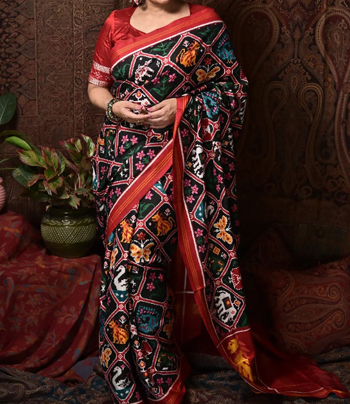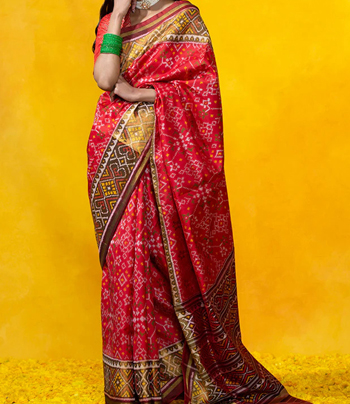Tangaliya Shwl
The tangaliya products are made up of natural and synthetic material or a combination of both. Since ages weavers have design vocabulary inspired by nature and their surrounding. Tangaliya motifs have a very geometric and graphic feel to it. The emphasis is on basic shapes like squares, 67 rectangles, triangles and circles. The placement of each dana is done precisely by calculating the distance between the warp and the weft yarns. Lots of contrasting colors are used in danawork. Commonly used colors are Blue, Green, red, pink, black, grey, maroon, purple and orange. White is used most prominently along with other colors. The most basic motif of Tangaliya is the Ladwa – it refers to a ladoo, an Indian sweet. The other predominant motifs are peacock, felt of peacock, Ambo tree (Mango tree), Khajuri (Date palm tree), peacock on bush, peacock with diamond shape motif, peacock on bunglow and peacock on aeroplane motif.
Kachchh Shawls
Kutch is known for its colourful shawls, woven with motifs which have been passed down through generations of artisan communities. They were originally made from local desi wools and were traditionally worn as veils. The shawl featured here incorporates the traditional motifs inspired from Deshi Dhabda (The woolen blanket). Artisans continue to design and produce shawls for the local market as their shawls are widely worn throughout Kutch in the winter months. The 1980s introduced a variety of yarns including cottons, wools, and acrylics to the craft. Types of shawls: The shawls made in acrylic wool are dyed in chemical dyes and hence have one solid bright colour throughout without any Tie Dye (Bandhani). The cheapest ones are the ones which have artificial zari borders with a little able work done on them. The merino shawls are woven and then dyed along with Tie Dye (Bandhani) patterns and in two or more colours. They also have Abla work, the amount of which depends on the design. A section of the acrylic shawls and merino shawls are in solid colours and have various types of embroideries as the only surface embellishments. Stole – A size version of Shawl: This stole is the small size version of Shawl. The Stole is result of artistic collaboration facilitated by KHAMIR. A Dutch designer worked with local artisans to incorporate traditional motifs into new product designs. This stole is hand woven on a pit loom using imported Marino Wool. It is 18 inches wide.
Patan Patola
Patan Patola are the finest example of ikat known in the world, which is the double ikat, where the warp and weft are tied and dyed before they are woven. The patterns emerging in the Patan Patola are much more defined, with a very good finish compared to any other ikat available in the world. Patan Patola are pure silk double ikat saree-like wearable fabrics, whose gorgeous colours and striking designs are the products of exquisite workmanship. Besides sarees, dupattas, handkerchiefs, tablecloth, lace, etc. can also be prepared from the Patan Patola. They resemble printed cloth, but are far different from any printed cloth. There are several ways of systematically classifying the various types of Patan Patola. They can be grouped according to size and use, according to the number and arrangement of patterned parts and according to pattern motifs. There are some 10 basic patterns, mainly of plant, zoomorphic and geometrical motifs. Customarily, different groups of buyers require different designs, usually following the dicta of their religion. In a weaving technique so complicated, it is natural that geometrical motifs should predominate. These were used in variations between the border and body pattern, with the motifs sometimes enlarged in the pallu (the end portion of the patola). The plant, animal Patan Patola are parrots, elephants, plants, ladies, flowers, trellis, baskets, leaves, etc. These are used in many different permutations and combinations for the body, border and the pallu, making different designs. Among the main designs, the popular ones are: Narikunjar, Ratanchawk, Navaratna, Voragaji, Chhabdi bhat, Chokhta bhat, Chanda bhat, Pan bhat, Phul bhat, Laheriya bhat, Tarliya bhat, Zumar bhat, Sankal bhat, Diamond bhat, Star bhat, Butta bhat, Sarvariya bhat, etc.Patan Patola normally uses red or vermilion as the background colour. The other colours that are used for dyeing along with red are yellow, orange, pink, green, blue, purple, white and black.
RajKot Patola
Single Ikat woven sarees of Rajkot Patola
• Rajkot Patola are pre-industrial creations and have rare and unique texture
• Length of RAJKOT PATOLA is from 5 to 8 yards
• Weight of Rajkot Patola is from 460 to 520 grams
• A Rajkot Patola are totally hand created and no machine is used
pproximately 20 -22 denier x 6 ply (total 160 to 176 filaments) special pure raw silk is used Length of the weft thread is as per the design unit (i.e) Unit Length (Approx) 30 1450 inch 40 1950 inch 48 2025 inch 52 2525 inch 60 2920 inch 72 3510 inch Minimum 2 pieces of saree of same colour combination and design are prepared. Each saree is a single piece with or without a Blouse piece.
Single Ikat woven Silk saree (Rajkot) The term ikat stems from the Malay-Indonesian expression ‘mangikat’, meaning to bind, knot or wind around. In principle, ikat or resist dyeing involves the bundled yarn to a predetermined colour scheme prior to weaving. The three basic forms are single ikat, where either warp or weft threads are tied and dyed prior to weaving. While numerous legends and oral traditions indicate the existence of the single ikat technique in India in prehistoric times, the 6th century frescoes of the Ajanta Caves provide the first visual records of it. Silk saree patterns were discovered in the 16th and 17th century frescoes in the South Indian temples and palaces of Padhmanabhpuram and Tiruchirapalli. GI Journal No. 77 28 November 30, 2015 This single Ikat woven saree is about sixty years old. The silk fabric is made in Rajkot (Saurashtra). They are ikat textiles but usually patterned only in the weft with a monochrome red warp. With regard to motifs, colours, arrangement of patterns and size are over-marketed under this name as patola made in Gujarat. They come from the workshop and weaving school of Karamchand Godhamdas in Rajkot in 1951
Intellectual Property India

